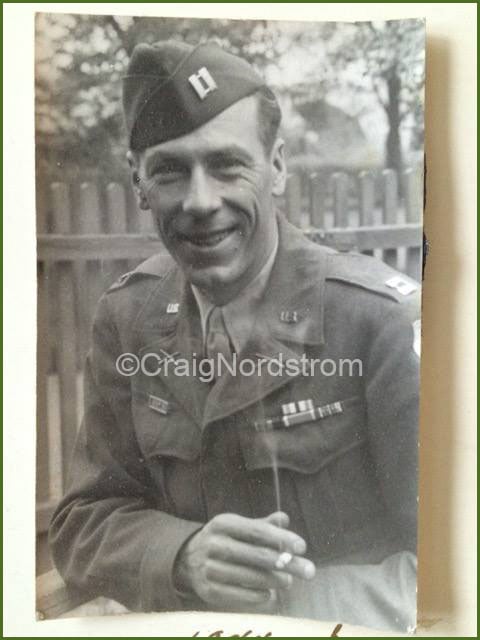The battle of Hatten was now on, the young and unexperimented German soldiers met until then by the US Troops had given way to determinated veterans and 79th Infantry Division had to deal with them.
During the night of January 10th to the 11th, German artillery continued to fall on Rittershoffen and Hatten while men had to continue their mission of clearing out Hatten of enemy soldiers. 2nd Battalion of the 315th Infantry Regiment Command Post at Rittershoffen was hit during the night, telephone communications were cut off. It was a real mess! With the sound made by friendly and enemy tanks plus artillery, radios were not completely satisfactory. It was possible to hear communications of tank crews making interferences between all radios which made impossible for anyone to understand what they were saying and requested.
If you have read our blog 79th Infantry Division – Operation Northwind: Hold Hatten you are aware now that Captain Tennyson L. Nordstrom C.O of “F” Company asked the support of tanks on January 10th at 0200pm right? Well, those tanks will show up…during the night. One platoon under the command of 2nd Lieutenant Robert F. Jones broke through Hatten by placing two M-18’s at the west of the main street, two in the middle 50 yards away of the “bend”*, running back and forth between five destroyers to give instructions to the tank commanders, unconcerned for his own safety. *See the map below.
 Captain Tennyson L. Nordstrom - ©CraigNordstrom
Captain Tennyson L. Nordstrom - ©CraigNordstrom
Sergeant Spencer Irving was one of the commanders of the tanks, hidden by the houses of the street triangulation, he could see enemy tanks before they could see him. Enemy tank crews didn’t have any chance, once they would have crossed the Rittershoffen – Hatten road it would be too late. Sergeant Irving was well hidden but it had men of “G” Company well dug-in everywhere around him and he asked one boy “Jackson, how does you want them? One, two, three or three, two, one? Ah’ll thinks Ah’ll take them one, two, three” . Being successful in knocking-out three tanks in a row, armored and infantry worked perfectly together. While crews tried to evacuate their vehicles “G” Company’s men and Sergeant Irving’s machine guns got all of them.

The entire 2nd Battalion engaged the enemy at close range during the night and very early in the morning. “F” Company in the southern part of Hatten repulsed enemy troops and also tanks coming from the church but one of them came close enough from US positions and fired on the houses occupied by the company. “Daisy Chains” mines were dug-in to stop the tank and Captain David R. Harding called for artillery support between 0630am and 0730am.
At 0530am on January 11th, 3rd Battalion of the 315th Infantry Regiment had come up to Rittershoffen during the night, established dug-in positions in a semi-circle from the northeast to the southeast*. Once German artillery fire over, the enemy resumed its attack with troops and tanks from the north of Hatten toward Rittershoffen. 3rd Battalion’s positions were overrun, 2nd Battalion’s Command Post was taken by surprise, three antitank guns were “steam-rolled” but gunners had the time to destroy them before to retreat. *See the map below

Germans were well-prepared, dressed in an all-white uniform, they blended perfectly into the landscape. Because of the snow and their uniforms, some of them succeeded in infiltrating the barns across from the Battalion Command Post and launched an attack onto the building. During the morning when the attack onto the command post of the 2nd Battalion abated, Headquarters Company organized defensive positions, no longer having the choice command post group retreated to Niederbetschdorf where they would be staying for the next nine days.
After the retreat and once everyone was safe, everyone, cooks, motor pool personnel, “I” and “R” Platoon formed a line of defense extending from the eastern edge of Hatten to the railroad at the south. Thanks to the Headquarters Company which remained during the entire battle at Rittershoffen, the supplying Niederbetschdorf – Rittershoffen road stayed open.
 The railroad tracks between Hatten and Rittershoffen
The railroad tracks between Hatten and Rittershoffen
The objective for the Germans at Rittershoffen was the train station at the south, this point became critical because of its use as a relay station, a collecting and supply point was never allowed to fall into enemy hands.
Street fighting kept going the all day and after dark, mostly of time at close quarters. January 11th, is the day when 2nd Battalion had been completely cut off from the rest of the world as the enemy had the control of the Rittershoffen – Hatten road.

Through the night of January 11th to the 12th, Germans made two attempts to penetrate 2nd Battalion’s positions with tanks. Both were repulsed by small arm fire and artillery but their strengths were reduced to almost nothing, Germans knew that men were completely surrounded. They just had to give the final blow with their tanks. The only thing able to save the 2nd Battalion ? Tanks from the 14th Armored Division.
Written by Pierre Fallet - Normandy American Heroes

















